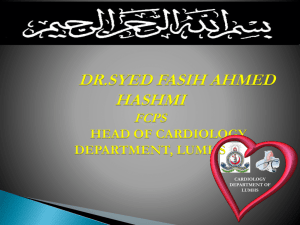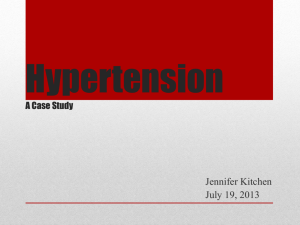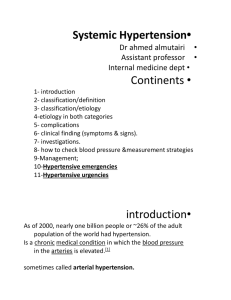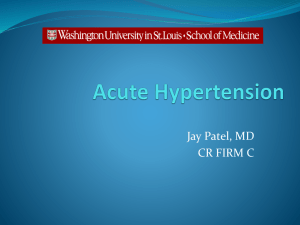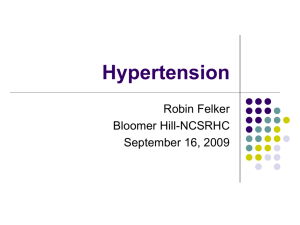Hypertension
advertisement
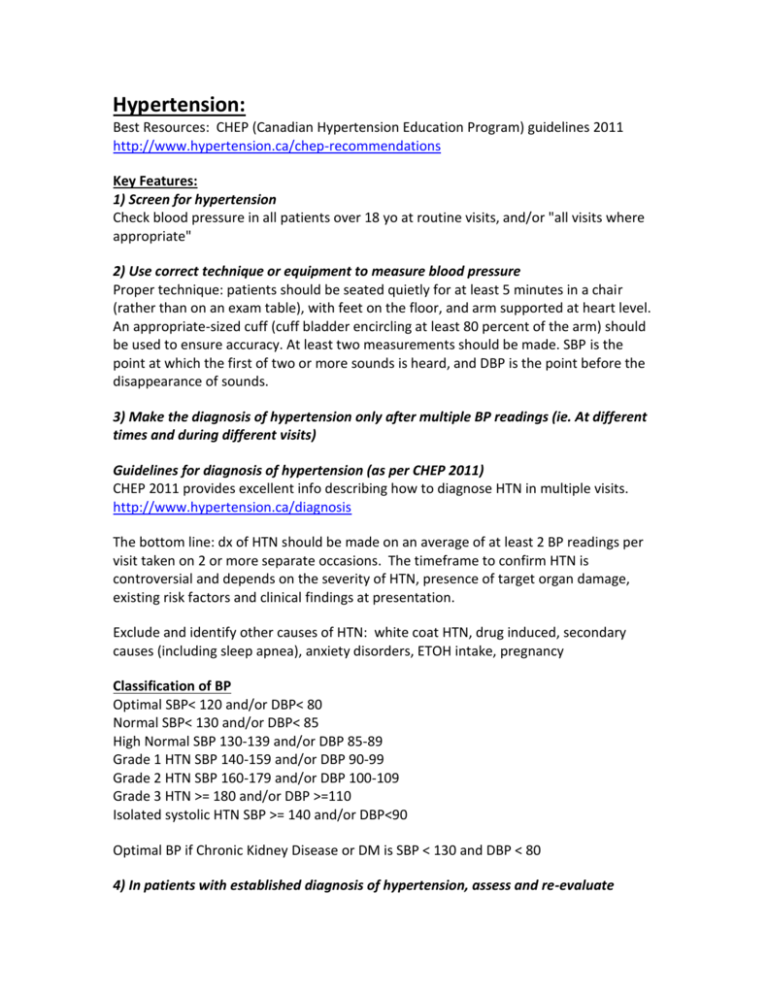
Hypertension: Best Resources: CHEP (Canadian Hypertension Education Program) guidelines 2011 http://www.hypertension.ca/chep-recommendations Key Features: 1) Screen for hypertension Check blood pressure in all patients over 18 yo at routine visits, and/or "all visits where appropriate" 2) Use correct technique or equipment to measure blood pressure Proper technique: patients should be seated quietly for at least 5 minutes in a chair (rather than on an exam table), with feet on the floor, and arm supported at heart level. An appropriate-sized cuff (cuff bladder encircling at least 80 percent of the arm) should be used to ensure accuracy. At least two measurements should be made. SBP is the point at which the first of two or more sounds is heard, and DBP is the point before the disappearance of sounds. 3) Make the diagnosis of hypertension only after multiple BP readings (ie. At different times and during different visits) Guidelines for diagnosis of hypertension (as per CHEP 2011) CHEP 2011 provides excellent info describing how to diagnose HTN in multiple visits. http://www.hypertension.ca/diagnosis The bottom line: dx of HTN should be made on an average of at least 2 BP readings per visit taken on 2 or more separate occasions. The timeframe to confirm HTN is controversial and depends on the severity of HTN, presence of target organ damage, existing risk factors and clinical findings at presentation. Exclude and identify other causes of HTN: white coat HTN, drug induced, secondary causes (including sleep apnea), anxiety disorders, ETOH intake, pregnancy Classification of BP Optimal SBP< 120 and/or DBP< 80 Normal SBP< 130 and/or DBP< 85 High Normal SBP 130-139 and/or DBP 85-89 Grade 1 HTN SBP 140-159 and/or DBP 90-99 Grade 2 HTN SBP 160-179 and/or DBP 100-109 Grade 3 HTN >= 180 and/or DBP >=110 Isolated systolic HTN SBP >= 140 and/or DBP<90 Optimal BP if Chronic Kidney Disease or DM is SBP < 130 and DBP < 80 4) In patients with established diagnosis of hypertension, assess and re-evaluate periodically the overall cardiovascular risk and end-organ complications • take an appropriate history • do the appropriate physical exam • arrange appropriate laboratory investigations History: Cardiovascular Risk Factors Age>= 55, Male, Fhx of premature CVD (Men < 55, Women < 65), Sedentary lifestyle, Poor diet, Obesity, Smoking, IGT or DM, Dyslipidemia, Stress, ethnicity (black african and black carribean), familial hypercholesterolemai or other inherited dyslipidemia • Ask about target end organ damage: H/a? Visual changes? Altered LOC? Hematuria? Oligouria? Angina? Previous MI? Previous revascularization? Previous CHF? Previous TIA? Previous stroke? Claudication? • Also consider asking about causes of secondary HTN, see below Physical Exam: Fundoscopy, Full cardiac exam (PMI for LVH, Renal bruits, Peripheral pulses, JVP, Peripheral edema, Differing BP in each arm). Routine Investigations: CBC, Urinalysis, Fasting Glucose, Electrolytes, Urea, Creatinine, eGFR, Fasting Lipids, ECG (assess for LVH or past MI) Target Organ Damage Investigations: Urinalysis, urine ACR (there are no good guidelines to suggest when you should do a urine ACR, CHEP is not currently recommending it annually) 5) In appropriate patients with hypertension (eg. Young patients requiring multiple medications, patients with an abdominal bruit, patients with hypokalemia in the absence of diuretics) suspect secondary hypertension, investigate appropriately. Causes of secondary HTN: (this is a big topic i can't go into all of it here, but the big ones are sleep apnea, renovascular disease, primary hyperaldosteronism and iatrogenic (drugs). Other less common are Cushings (central obesity, moon facies, supraclavicular fat pads, humpback, OP, striae, psychological changes) hyperthyroid, hypothyroid, hyperparathyroid (high calcium & high PTH) pheochromocytoma, coarctation of the aorta (radio-femoral delay). (Drugs include OCP, stimulants, MAOIs, SSRIs, licorice root!, EPO, NSAIDs, decongestants, anabolic steroids, withdrawal of BBs or clonidine, Vanco, Carbamazepine, Levodopa, anticholinesterase eye drops) -Suspect renovascular HTN if: Sudden onset or worsening of HTN age >55 or <30 years, presence of abdo bruit, HTN resistant to 3 txs, other atherosclerotic vascular disease, recurrent pulmonary edema associated with hypertensive surges -The following tests are recommended, when available to screen for renal vascular disease: • captopril-enhanced radioisotope renal scan (this is recommended for those with GFRs <60 mL/min) • doppler sonography • magnetic resonance angiography • CT-angiography (for those with normal renal function) -Hyperaldosteronism should be considered for patients with the following: spontaneous hypokalemia (<3.5 mmol/L) profound diurietic induced hypokalemia (<3.0 mmol/L) hypertension refractory to treatment with 3 or more drugs incidental adrenal adenomas -Screening for hyperaldosteronism should include plasma aldosterone concentration (PAC) and plasmin renin activity (PRA), aldosterone: renin ratio >25 suggestive or hyperaldosteronism (PAC/PRA) • aldosterone should be measured in morning samples • (aldosterone antagonists, ARBs, beta blockers and clonidine should be discontinued prior to testing) -Consider pheo if paroxysmal and or severe sustained HTN refractory to usual antihypertesnive therapy, HTN and symptoms suggestive of catecholamine excess (headaches, palpitations, sweating etc) Pheo HTN may be triggered by BBs, MAOIs, micturition or changes in abdo pressure Think of multiple endocrine neoplasia (MEN 2A or 2B) To test include 24 hour urine for metanephrines and catecholamines, assessmentof urinary VMA is inadequate. A normal pasma metanephrine level can be used to exclude pheochromoytoma in low risk patients but the test is performed in few labs -83% of refractory hypertensives have sleep apnea! Do sleep studies. -Dexamethasone suppression test for Cushing’s syndrome 6) Suggest individualized lifestyle modifications to patients with HTN (eg. Weight loss, exercise, limit alcohol comsumption, dietary changes) • Recommend weight loss to BMI 18.5 - 24.9 kg/meter squared • Recommend alcohol intake <2 drinks per day for men = 14 drinks per week, <1 drink per day for women = 7 drinks per week Recommend waist circumference <102 cm for men, < 88 cm for women • DIET: DASH diet (rich in fruits, veggies, low fat dairy, soluble fibre, whole grains, protein from plant sources, reduced saturated fat and cholesterol • Sodium intake --> the guidelines are getting more and more strict!!! <1500 mg sodium for anyone 50 yo or less, 51-70 = <1300 mg, > yo = <1200 mg. Note sodium and 'salt' are not the same thing, salt is NaCl, thus 5 grams of salt may only be 3 grams of sodium. http://www.hypertension.ca/lifestyle-management 7) In a patient diagnosed with HTN, treat the HTN with appropriate pharmacologic therapy (eg. Consider the patient's age, concomitant disorders, other CVD risk factors). How do you choose the appropriate drugs? The basics of this are that you should choose a drug based on other co-morbidities. Ie) diabetes are microalbuminuria, use an ACEI/ARB. If no comorbidities, choose a thiazide as first line (the ALLHAT trial showed thiazides are great, cheap and work well when compared head to head with the others) If BP is more than 20/10 ideal, it is considered acceptable to start with 2 drugs. 2/3 of patients will need 2 drugs to control their HTN, 2/3 of DM will need 3 drugs. A good summary chart of what drugs to choose for certain comorbidities is found on the CHEP website. 8) Given a patient with the signs and symptoms of hypertensive urgency or crisis, make the diagnosis and treat promptly. Hypertensive urgency – BP >=180/120 with NO symptoms except maybe some h/a Hypertensive emergency – BP>=180/120 with symptoms (h/a, visual changes (retinal hemorrhages/exudates, papilledema), malignant nephrosclerosis (hematuria, proteinuria, ARF), cerebral edema, SAH, ICH (h/a, nausea, vomiting, altered LOC, seizures, coma) Treat hypertensive crisis appropriately Hypertensive Urgency – Usually BP is treated over hours to days. Can use oral agent to bring BP down then start a long acting agent once BP is shown to have stabilized on the initial oral agent. Clonidine, captoporil, hydralazine, nifedipine (used to be used a lot more, now is contraversial) Hypertensive Emergency – Usually BP treated in 2 to 6 hours Parenteral agents allow for better BP titration and for faster onset and are therefore used in this situation (although there are a few oral meds that can be used if limited access to parenteral medication). Nitroprusside infusion at 0.25mcg/kg/minute Nicardipine infusion at 5-15 mg/hour Labetalol bolus of 20mg, followed by 20-80 mg boluses q 10 minutes to a maximum of 300mg. Labetalol infusion 0.5-2mg/minute 9) In all patients diagnosed with HTN, assess response to treatment, medication compliance, and side effects at follow up visits. Adverse Effects - CCBs - peripheral edema, headache, dizziness, flushing - Beta blockers - fatigue, dizziness, syncope, weight gain, sexual dysfunction, negative chronotropic effects, orthostatic drop - ACEI - hyperkalemia, cough, angioedema, hypotension - Thiazide diuretics - hypokalemia, hyponatremia ASSESS COMPLIANCE AT EVERY VISIT! CHEP EMPHASIZES THIS!

